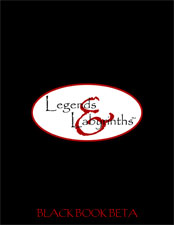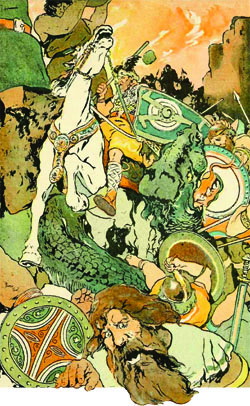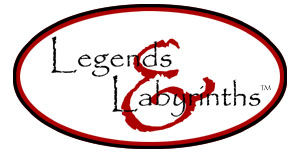 Many of the readers on this site have been waiting years for Legends & Labyrinths to arrive. Now that it has, at long last, done so, I wanted to talk a little bit about the long road it’s followed.
Many of the readers on this site have been waiting years for Legends & Labyrinths to arrive. Now that it has, at long last, done so, I wanted to talk a little bit about the long road it’s followed.
SIMPLY D20
The origins of the Legends & Labyrinths project actually go all the way back to 2003 when I began work on a project known as Simply D20. Simply D20 was a deconstruction of the 3rd Edition and Modern D20 rulesets into a basic, generic game system suitable for any genre. It stripped down the class list to a “generic core” of Expert, Fighter, Mystic, and Rogue. It would have included separate skill lists for Fantasy, Modern, Cyberpunk, and Space Opera settings. It would have included six “sample races” (Human, Dwarf, Elf, Saurian, Felines, and the Klingon-like Battaks). And so forth.
The project began running into development problems, however, because its design goals ended up conflicting with each other. I wanted:
1. A very small rulebook (50 pages).
2. A generic set of rules to handle any genre.
3. Compatibility with 3rd Edition
But these could not all be achieved at the same time. Primarily, the additional options required for a fully functional and generic ruleset made the small rulebook unattainable and maintaining compatibility with 3rd Edition an ongoing struggle.
The release of 3.5 killed the Simply D20 project along with a lot of other projects I was working on and, ultimately, drove me out of the RPG freelance biz for a few years.
SIMPLY D20 FANTASY
In the spring of 2006, the project (sort of) rose from the ashes as Simply D20 Fantasy. Naturally revamped to use 3.5 as a base, the game’s main selling point was now “100% compatible with 3rd Edition!”. Its core design principles were now fundamentally identical to Legends & Labyrinths as it exists today.
Now, however, I let the project get out of control in a different way: I wanted to include mass combat, siege warfare, naval battles, chases, social duels, tourney, castle building, and realm management rules… all in 100 pages!
My problem was that I had been seduced by a false vision of the “good ol’ days”. I wanted a rulebook like my old BECMI Basic Set and so I said: “That was only a few dozen pages! I should be able to fit the full rule system into 50 pages or so and then use the rest of the space to include stripped down versions of all these other rulesets (just like I’m stripping down combat)!”
But, of course, the BECMI Basic Set only included rules for levels 1-3 — which allows it to conserve a lot of space when it comes to things like magic items and spell lists.
I’d later face a similar design problem in trying to recapture the simple glory of “roll attributes, pick a race, pick a class” as a method of character creation. It took me a ridiculous amount of time to realize that the reason I couldn’t capture that simplicity of character design is because it had never actually existed. (Legends & Labyrinths now features a character creation process which is pretty comparable to OD&D and BECMI in terms of the time and complexity involved.)
Problems like these bogged the project down and I laid it aside for awhile.
FINDING A NAME
When I returned to it in late 2006, I decided to abandon the name “Simply D20”. Instead I started chewing my way through alliterative titles trying to find one that worked: The game almost became Wizards & Warriors, but a succession of people had used the name and it had most recently been registered by a CRPG company in 2000 and I couldn’t determine whether the mark was still in use. Other possibilities included: Warriors & Warlocks, Mazes & Minotaurs, Magic & Monsters, Wyrms & Warriors, Spells & Swords, Swords & Sepulchers, Myths & Magic, Nymphs & Nightmares, Fable & Fantasy, Runes & Reliquaries, Chronicles & Catacombs, Sword & Saga, Princes & Perils, and Swords & Scrolls.
Some of these got rejected because they were already in use. Others because they sucked. Others because they didn’t feel as if they represented the totality of the game. Eventually I settled on Legends & Labyrinths (which had only been used previously in the early ’80s for a shareware Japanese CRPG that was long since defunct).
At this point, however, the project was still stuck in the same development trap it had been stuck in before. And I decided to add another bit of developmental stupidity by trying to go all-inclusive with my simple, stripped-down game. The race list now included: Humans, artathi, centaurs, dwarves, elves, gnomes, goliaths, half-elves, half-orcs, halflings, orcs, reptakkens, and siarrans. I was also trying to include not only every class from 3rd Edition, but also cavaliers, duelists, psions, psychic warriors, scouts, and spellsongs.
There was a method to this madness, but it wasn’t negating the fact that the project was still fighting with itself. After struggling with the project in this state for several months, it was collapsing under its own weight. In early 2007, however, I changed direction and began stripping everything back down to the simple core it was always supposed to be.
LEGENDS & LABYRINTHS
But then 4th Edition was announced at GenCon in August 2007.
The announcement prompted me to put Legends & Labyrinths on hold. Remember that this same project had been killed by the 3.0 to 3.5 transition, and I felt it didn’t make much sense to get burned again in the same way. At this point my plan was to wait for 4th Edition to be released and then release Legends & Labyrinths as a 4th Edition game.
This, of course, was predicated on the assumption that: (1) 4th Edition, like 3rd Edition before it, would be a continuation of the same game that had existed since 1974. (2) That WotC would continue supporting the OGL.
By the end of May 2008, it was clear that neither of these things were true. At this point I decided to put L&L back into development. By late June it looked like everything was falling into place: I had a draft that was 85% complete. I had lined up some beautiful cover art. I had put together a significant art budget that would allow me to purchase reprint rights for existing, high quality fantasy art.
Based on previous projects, I knew that I had roughly 2-3 weeks worth of work ahead of me. I also felt that, with 4th Edition coming, I needed to strike while the iron was hot and let people know that the game was coming. So I rebranded my existing OGL products, announced a July 15th release date, and got down to work.
EVERYTHING FALLS APART
What follows may sound like a litany of excuses. They’re not meant as such. It’s meant to be simply a description of what happened. I hope it can be taken in that sense.
In early July 2008, my computer crashed. This turned into a nightmare: I had all my data backed up, but I couldn’t recover the machine. So I spent money like a drunken sailor to buy a new computer… only to discover that the versions of Quark and Acrobat I owned wouldn’t run on Windows Vista. So then I tried to install Windows 2000 on the new computer, but necessary device drivers didn’t exist for Windows 2000. So then I spent more money to get my old computer reconstituted. (If I recall correctly, it turned out that both the motherboard and the auxiliary hard drive controller had burned out.)
By this point, I had lost 10 days of work. After describing the situation, I rescheduled the release date for Legends & Labyrinths to July 31st and continued work.
… which is when I contracted Lyme disease. (I was apparently bit by an infected tick while working at an outdoor Shakespeare company.) The Lyme disease turned into its own little odyssey: The first doctor I saw prescribed 10 days of antibiotics. I took them… and then, a few days later, I started getting sick again. So I went back to the clinic. This time I saw a different doctor, who promptly opened a medical reference book, looked up Lyme disease, and read: “Prescribe 14-21 days of antibiotics.” The first doctor had under-prescribed and the antibiotics hadn’t actually wiped out the disease. Since I had been off the antibiotics for several days at this point, I needed to start the regime over from scratch. And since the remaining disease was probably more resistant to antibiotics (having survived the under-prescribed round of treatment), I’d need to take a full 21 says worth of pills. (I did do and fully recovered; but by the end of it my kidneys weren’t too happy with me.)
By this point the deadline had slipped again. This time I simply announced that it would be “done when it’s done”. I also decided to take advantage of the extra time to retrench, rewrite some problematic sections of the book, and tweak the layout.
In late August 2008, however, it all fell apart.
Continued tomorrow…















